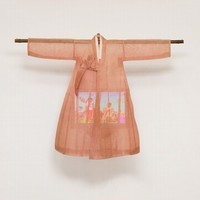Ommah
Item
-
Title
-
Ommah
-
Description
-
In 2005, the year before his death, Nam June Paik created Ommah (""mother"" in Korean), his last work of video sculpture, a genre that he invented in the early 1960s. The work is a moving summary as well as a lighthearted look back at a long and winding career.
In Ommah, a traditional robe that might have been worn by a well-off Korean boy some 100 years ago hangs nearest to the viewer. Through its lightweight silk, images on an LCD TV monitor can be seen, but not without the irritation of a moiré pattern caused by the interplay of the two ""screens."" The monitor plays a program lasting several minutes and looping continuously. Three Korean American girls in traditional costumes dance, play ball, beat a drum, and ride in a toy car, seemingly carefree but carefully choreographed by Paik. The back-ground imagery includes close-up views of early video games, footage from TV shows, and material from Global Groove, the video Paik made for WNET-TV in 1974, all manipulated using a high-tech version of the color video synthesizer Paik coinvented around 1970. The music includes ambient sounds of the studio, both straight and processed, and snippets from Paik's own experimental music tapes of the 1950s.
As stable and iconic as this cruciform work appears, our physically moving before it is vital as we pass back and forth, trying to peer through or around the robe. Paik attacked the passivity that he felt television imposed on viewers. Through endless play with the medium, he reclaimed the ""boob tube"" as an expressive, democratic tool. A Fluxus-inspired trickster crossing high culture with low, Paik never lost the homemade, improvised quality of his earliest experiments.
To complement this gift of the Collectors Committee, Paik's nephew Ken Hakuta has donated an early work. Untitled (Red Hand), 1967, also employs a found antique as a screen (in this case a 19th-century Japanese scroll painting) through which light (in this case a blinking bulb) is projected. The bulb illuminates a handprint, presumably the artist's own, made on the glass of the frame. The scroll's comical figure with bulging eyes combines with these other elements in a humorous meditation on authorship and scavenger hunting, technology and tradition. Together these two works constitute a landmark acquisition: they are the first sculptural objects by Paik to enter the collection, and Ommah is a key addition to our nascent collection of works in time-based media.
-
Date
-
2005
-
Extent
-
19-inch LCD monitor
-
Subject
-
Site-specific art
-
Identifier
-
NJP10
 Ommah
Ommah